Don’t dismiss offal too quickly... when cooked the right way, it provides a healthy, protein rich and tasty treat. Tim Maddams shows us how
 credit: Archant
credit: Archant
There are many common mistakes made in meat cookery, and particularly in the cookery of offal. The most common of these is the tendency to serve strong-flavoured meats simply. This is fine if you are a massive fan of say, liver, but if you are not, or are not quite sure, then far and away a better approach is to pair strong meats with spicy, strong-flavoured ingredients to create a balance on the palate, and back it up with an aromatic starch to further improve things.
This dish will convert even the most steadfast liver sceptic to your cause and have them asking for more. I have to admit that I have pinched this particular dish from Hugh Fearnley-Whittingstall; although it’s an adaption, it’s only polite to credit the recipe’s previous owner.
To make the couscous, simply follow the instructions on the pack, then dress it up with olive oil, citrus, chopped herbs, chilli flakes and whatever else takes your fancy. I’ll leave it up to you, but do make the effort to get good couscous; there are some great organic wholemeal ones out there that are far removed from the standard stuff, and well worth the effort of getting hold of.
Getting hold of good-quality fresh liver may require a chat with the stalker, if you don’t stalk yourself, but a good game dealer should also be able to help.
Serves 2-3
Ingredients
For the liver:
? 400g fresh venison liver, thinly sliced
? ½ an organic red onion, sliced as thinly as you can manage
? organic rapeseed oil for frying
? 2 tsp coriander seeds
? 1 tsp cumin seeds
? 1 tsp fennel seeds
? 1 tsp good-quality smoked paprika
? 1 pinch of chilli flakes (optional)
For the garlic yoghurt:
? 1 small pot of organic yoghurt
? 1 tsp nigella seeds
? 1 clove of organic garlic, or a few leaves of wild garlic, finely chopped
? 1 sprig of mint, finely chopped
? 1 sprig of basil, finely chopped
Method
1. Place the liver and onions in a bowl and drizzle with a little of the rapeseed oil.
2. Toast the whole seeds in a dry pan until aromatic, then grind in a pestle and mortar until you have a fine powder. Add the paprika, and a few chilli flakes if you wish, then dress the liver and onions with two thirds of this mixture. (Don’t add any salt yet – liver cures very quickly and if you season it with salt at this point it may well leach blood everywhere.)
3. Mix the yoghurt, chopped herbs, nigella seeds and garlic together and refrigerate until required.
4. Place a large frying pan you know you can trust on a moderate heat and let it sit there for a few minutes to heat up. Now season the liver with a little salt and drizzle a small amount of rapeseed oil into the pan – it should be hot, but not quite smoking.
5. Add the liver and onions to the pan all at once, and don’t faff with it – bar making sure it’s all evenly spread out. If you are cooking a large amount, you may need to do this in batches so that it will cook quickly and evenly. You don’t want the pan to cool down or the liver to overcook, you want it just cooked and juicy, so remove it from the pan while it’s still a little raw in the centre and allow the residual heat of the liver to finish the cooking.
6. Rest the liver for five minutes, then serve it up with the couscous and yoghurt. Lemon or lime wedges can be served for squeezing over the liver. The remaining spice mix is great to sprinkle over the whole dish as a table garnish and really lifts the whole thing.